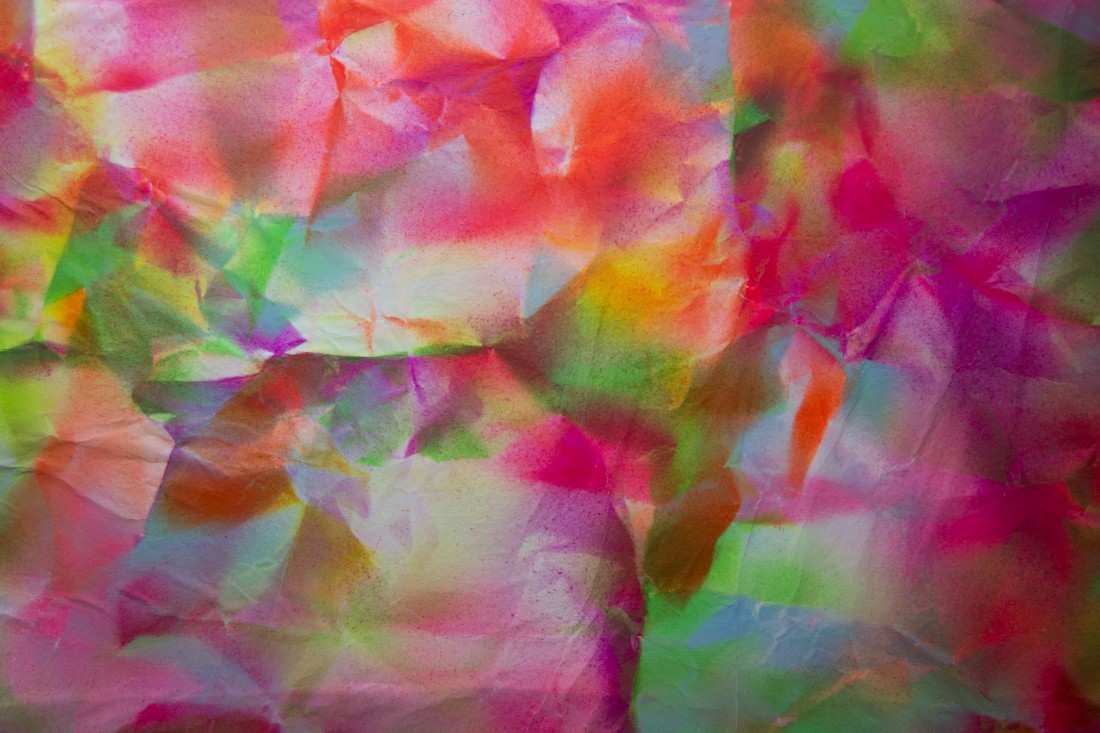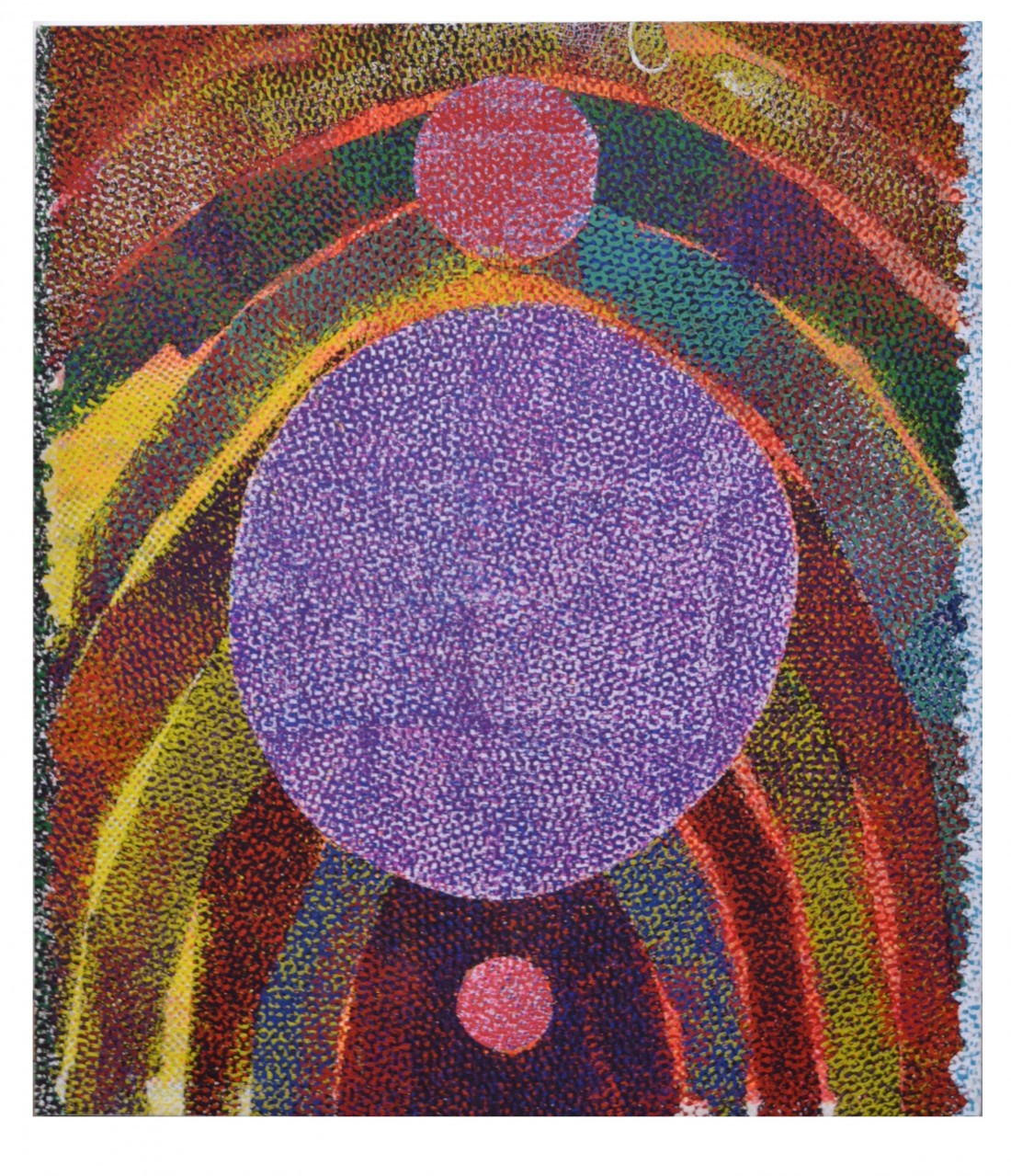“John Eisler: Lantern,” and “Janine Miedzik: Tie-Dye for Germans”
Angell Gallery’s parallel exhibitions of Janine Miedzik’s “Tie-Dye for Germans” and John Eisler’s “Lantern” bring together two artists for whom play is serious business. Miedzik’s canvas constructions transform the project space into a romper room of Day-Glo contemplation; Eisler’s intense chromatic experiments fill the larger gallery space with pictorial puzzles that draw deeply on our experience of painting. The pleasures to be had here are different, as are the procedures mobilized to engage with materials, but there is a remarkable similarity in how the viewer’s experience of these works changes over time. As with all forms of serious play, we start out learning the rules of engagement and end up with a profound sense of how such limitations set us free.
Miedzik has arranged five irregularly shaped canvas objects on the three full walls of the project space. You are immediately aware of their materiality: raw canvas has been creased and puckered; Day-Glo spray paint has been applied such that when the creases are flattened, interrupted patterns emerge; these variegated fields of raw canvas and paint are then cut and sewn together to generate maximal contrast between sections. Every seam, every stitch, every mark is laid bare. They become strangely biomorphic shapes that seem to cling to the wall like immense urban barnacles. Citing Lynda Benglis, Miedzik aptly refers to them as “super-saturated, unruly, freestyle tapestries,” but to say that they hang doesn’t do justice to how they project off the wall. What I found so intriguing was how I kept mentally unstitching the fragments, refolding the canvas in my mind, imagining how each interrupted layer of paint was applied. I was retroactively reconstituting the process of their making, and in so doing eerily invoked the playful actions of the artist. It’s not often that past time discloses itself in the present, but once this fluttering between the now of viewing and the then of making was activated, the conglomerated objects transformed into a living population of gorgeous high-vis detritus. Because you can find related canvas fragments across different objects, it is apparent that a great deal of thought has gone into how each object relates to the other. This is confirmed by the irregular Day-Glo wallpaper that covers the open fourth wall of the space—the titular Tie-Dye for Germans. The layered fields of orange, yellow and pink disclose themselves as a sort of zany gift: they are visible only once you enter the room, they are the last thing you see when you leave and they uncannily summarize the transformational experience Miedzik has staged in this tiny space.

Janine Miedzik, Tie-Dye for Germans, 2020, dimensions variable.
John Eisler comes at the large gallery with his characteristic ambition and insouciance. On the face of it he is showing wildly varied paintings. There are eight smaller paintings that replicate the same formal conceit using different patterns of coloured dots, but they are overshadowed by the four large works in the show. The most visually dominant, Aviary and Monster, are vibrant compositions of intense chromatic saturation. Electric pinks, acid greens, and bright blues and purples have been applied to thin plastic films to generate effects we often associate with printing more than painting. These plastic films are then cut, layered and affixed to large square fields of underlying acrylic paint. From a certain angle Aviary resolves into an immense sci-fi flower, a complex collage of hard diagonals and enclosed ellipses. Using the same electric palette, Monster is a vast grid in which each of the nine internal squares is haunted by a circular element. As with the “Cavity” series, Eisler employs a range of strategies to negate the presence of his hand on the way to exploring the pleasures of a desubjectified surface. Aviary and Monster are satisfyingly superficial paintings, by which I mean that their obviation of the painterly mark allows colour to billow forth almost unrestrained.

John Eisler, Untitled–field, 2020, acrylic on canvas, 42 x 37 inches. Images courtesy Angell Gallery, Toronto.
That these paintings are so “deeply flat” makes them such a brilliant pairing with the two other large paintings in the show, simply titled Curtain 1 and Curtain 2. As thrillingly exuberant as Aviary and Monster are, I was continually drawn back to these apparently more restrained works. The two Curtain paintings are “flatly deep”: Eisler has stretched PVC on a traditional 4 x 8 painting stretcher, painted one white, the other a charcoal grey, and then has punched or drilled holes all across the surface in contrasting linear patterns. In Curtain 1 the white field is perforated by diagonal lines of holes that radiate from two points high on each side of the stretcher; in Curtain 2 the grey field is perforated by randomly spaced horizontal lines of holes. A still horizon line of sorts emerges in the former; striped patterns emerge in the latter that render the holes optically active. The perforations allow for linear effects to emerge, but there are so many holes that we actually see through the PVC to the wall and the stretcher behind the surface. It is something that we look at and look through simultaneously, and thus we are left with puzzling set of questions: Where does the painting stop and start? Is it possible for painting to exist on the picture plane and behind it simultaneously? Does the contrast between interlocking diagonals in Curtain 1 and the horizontal patterning of Curtain 2 dialectically engage with painting’s long struggle with depth and flatness? And, perhaps most provocatively, aren’t all these same issues at stake in the superficially different Aviary and Monster paintings? For me, this is where Eisler’s show suddenly became something much more consequential than these four large works. I felt like I had fallen down some rabbit hole where profoundly dissimilar objects were blurring into one another and painting seemed to partake of the freedom of play. It had the satisfaction of the best kind of puzzle, the kind that expands your senses at the same time that it reminds you about the existing capacities of both your sensorium and your visual memory.
“John Eisler: Lantern” and “Janine Miedzik: Tie-Dye for Germans” were exhibited at Angell Gallery, Toronto, from February 1 to March 7, 2020.
Daniel J O’Quinn is a professor in the School of English and Theatre Studies at the University of Guelph and the author most recently of Engaging the Ottoman Empire: Vexed Mediations, 1690–1810, Penn, 2018.

